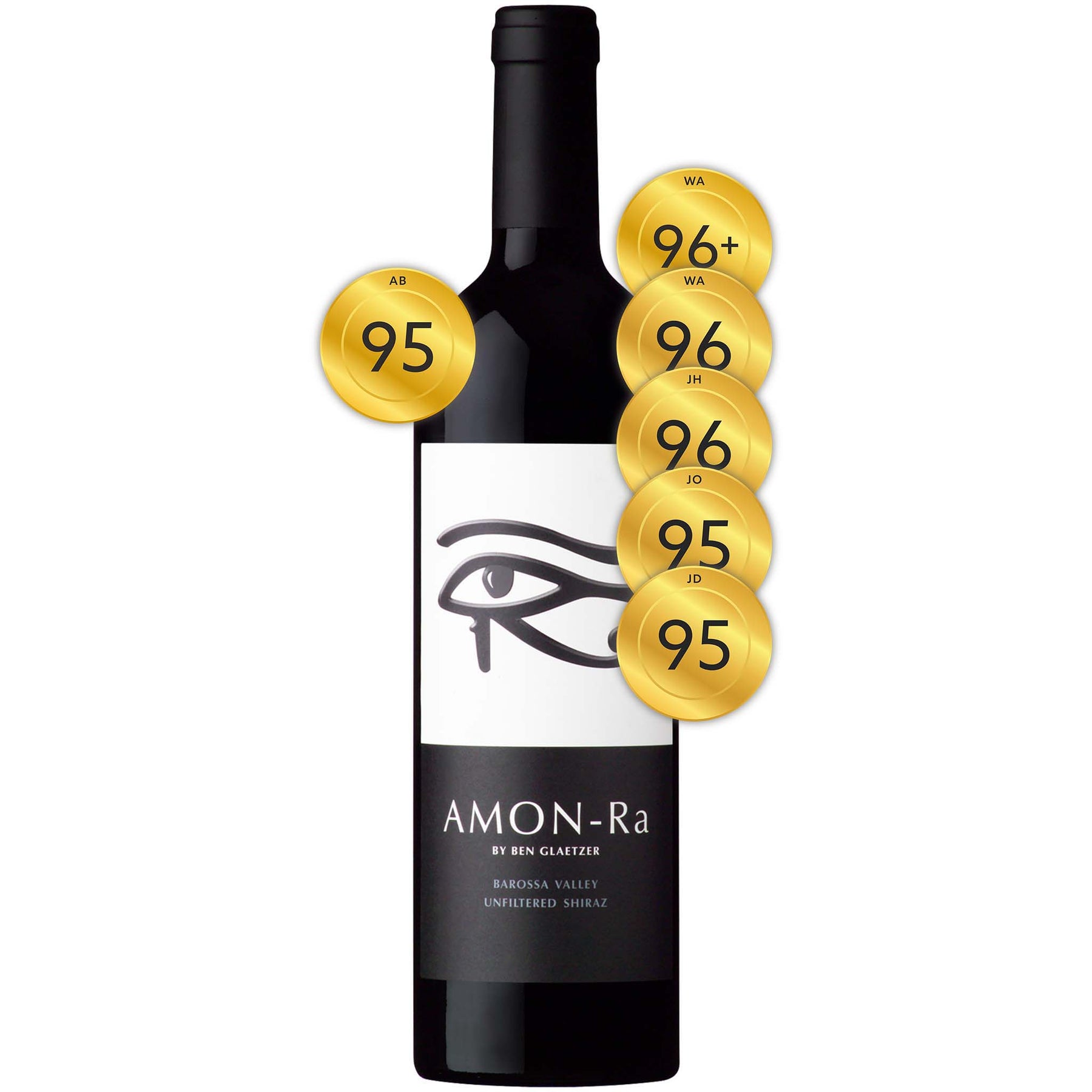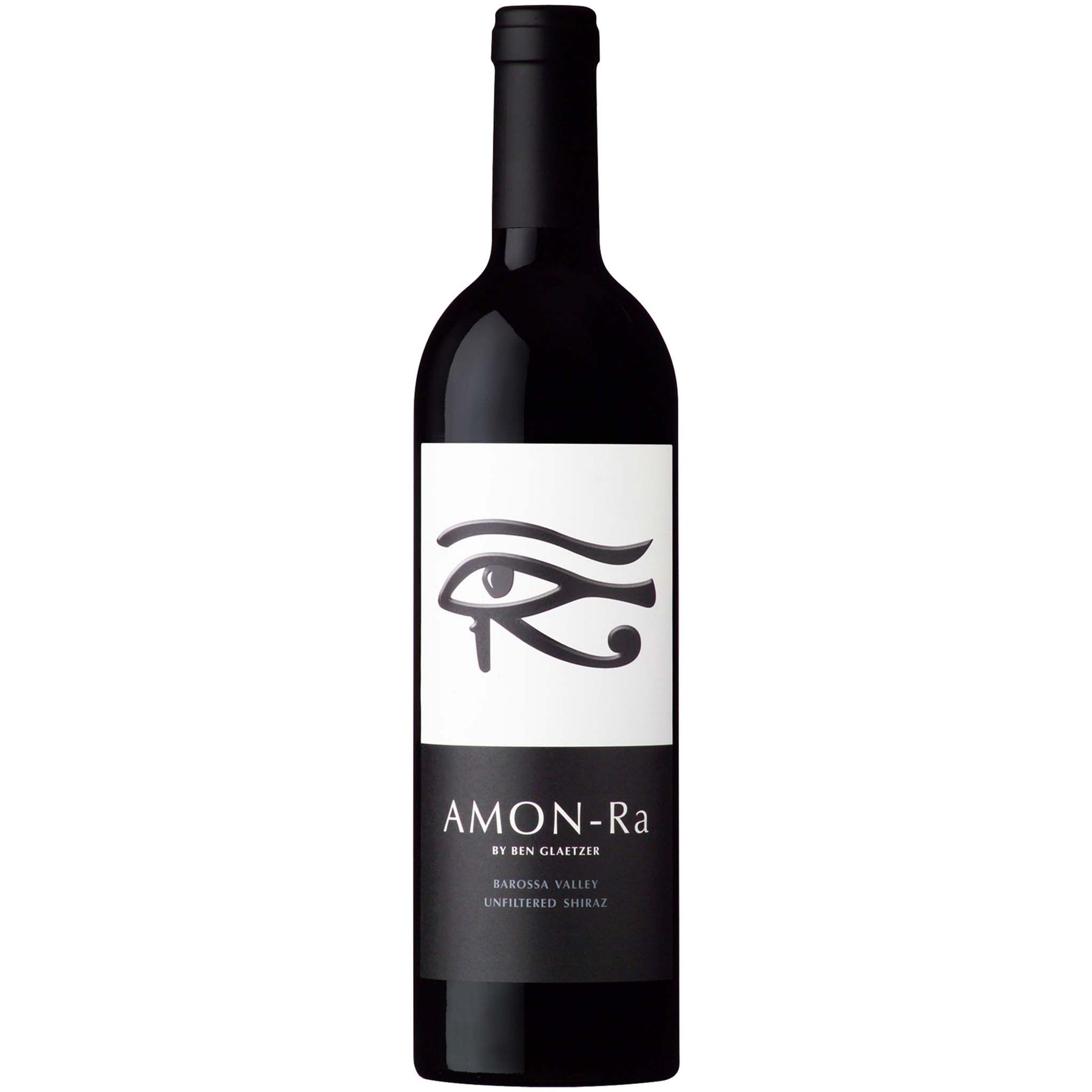

Glaetzer Amon-Ra Barossa Shiraz 2009
Style: Red Wine
Variety: Shiraz
Closure: Cork
Glaetzer Amon-Ra Barossa Shiraz 2009
Warehouse
34 Redland Drive
Vermont VIC 3133
Australia
Critic Score: 96
Alcohol: 14.5%
Size: 750 ml
Drink by: 2030
"Ben Glaetzer is a serious talent who has exploded on the wine scene with a brilliant array of wines." Robert Parker
Glaetzer Amon-Ra is a benchmark Barossa Valley shiraz made by master winemaker Ben Glaetzer. Fruit is sourced from exceptional old vines in the famed Ebenezer sub-region in the northern part of the Barossa Valley. Vine age varies from 35 years to over 130 years of age. Amon-Ra is Glaetzer's flagship wine and in addition to being a shiraz of monumental proportions, it displays a freshness and purity of fruit that are the hallmarks of Ben Glaetzer's wines.
"Has the usual dense purple-crimson colour; there is an elusive Arabian/exotic spice nuance to the bouquet, the palate proclaiming the exceptional quality of the fruit and the mastery of Ben Glaetzer, able to invest this shiraz with so much dark berry flavour yet retain elegance. A beautiful wine." James Halliday
Expert reviews
"The 2009 Amon-Ra Shiraz displays a very deep purple-black color and floral notes of violets and wilted rose petals over mulberries, blueberries, star anise, mocha, fenugreek, cumin seeds, cloves and tree bark plus some toasty oak. Full-bodied and rich yet not overly so, it has refreshingly crisp acid and firm grainy tannins texturing the long spicy finish. Give it at least 2 years more in bottle and consider drinking it 2013 to 2024+." Robert Parker, The Wine Advocate – 96+ points
"Has the usual dense purple-crimson colour; there is an elusive Arabian/exotic spice nuance to the bouquet, the palate proclaiming the exceptional quality of the fruit and the mastery of Ben Glaetzer, able to invest this shiraz with so much dark berry flavour yet retain elegance. A beautiful wine. Drink by: 2030." James Halliday, Halliday Wine Companion - 96 points
"Deep purple-black colored, the 2009 Amon-Ra has pronounced creme de cassis and blueberry tart aromas over notes of raw meat, fertile loam, yeast extract and cloves. More elegant in the mouth, it has a medium to firm level of very fine tannins, vibrant and fresh acid that lingers nicely through a long and fruity finish. It is approachable now and will cellar to 2025+." Lisa Perrotti-Brown MW, Wine Advocate - 96 points
"Modern, smooth and stylish, deeply and evenly ripened, with pleasing weight, elegance and suppleness. Rich and earthy but closed and withdrawn, its dense aromas of cassis and dark plums are knit with smoky, chocolatey oak. It's long, silky and luscious, with dense, briary and pastille-like flavours of small berries and plums artfully entwined with fine-grained oak, pliant tannins and fresh acids. Drink 2021-2029." Jeremy Oliver - 95 points
"Coming from the small Ebenezer sub-region in the northern part of the Barossa Valley, the 2009 Glaetzer Shiraz Amon-Ra Barossa Valley, 100% old vine Shiraz, is aged for 16 months in 100% new, mostly French oak (10% American oak, all larger styled hogshead barrels) for 16 months. The wine is fresh and perfumed on the nose, showing brighter styled notes of spiced blackberry and raspberry fruits, flowers, and underbrush that are rounded out by more base driven notes of earth, smoke, and pepper-laced nuances. The overall fresh profile continues on the palate where the wine is medium to full bodied, focused, and beautifully polished, delivering juicy acidity, a silky, energetic texture, and plenty of length on the finish. Taken as a whole, this is a more elegant, streamlined Amon-Ra that should benefit from 2-4 years in the cellar, and drink well for 12-15 years." Jeb Dunnuck - 95 points
"An unbelievable wine. Chocolate covered cranberries, blueberries, game, lavender, violets, spice. Great balance of acidity, alcohol, and fruit. The true modern face of Barossa. 95 points. Drink now through 2025." Andrew Bernardo, Ottawa Wine Journal - 95 points
About Ben Glaetzer

"When I look at the winemaker behind some of my favourite Australian wines, the name Ben Glaetzer seems to come up frequently. He is a serious talent who has exploded on the wine scene with a brilliant array of wines." Robert Parker
The irrepressible Ben Glaetzer is the driving force behind both Glaetzer, Heartland and Mitolo Wines. Glaetzer Wines, the sole family company, was set up by his father Colin in 1995 and makes red wines from ancient vines in the Barossa Valley. Heartland Wines, which makes less expensive wines from Langhorne Creek and Limestone Coast, was set up by Ben and fellow winemaker Scott Collett in the late 1990s. Then there’s Mitolo Wines, which focuses on McLaren Vale, which was set up in 2000 by Ben and horticulturalist Frank Mitolo.
Ben's early experience in the wine industry was working as a cellarhand at Barossa Valley Estates during school and university holidays. He originally had aspirations to be a pediatric surgeon – "I wanted to have an impact, but I didn’t want to fix sick people all the time." But the smells and sounds of the winery at vintage drew him back. "I’d been working vintages for 10 or 12 years. I came from a pretty ordinary medical lecture and walked into the winery and thought, it doesn’t get better than this." So he switched to studying winemaking at Roseworthy, Adelaide University’s agricultural college.
After graduation, Ben worked in the Hunter Valley at Tyrrell's and travelled extensively through the world’s wine regions. In 1998, he returned to the Barossa and joined his father’s business. The family’s day-to-day business is its high volume winemaking operation at the Glaetzer winery, which is able to crush 10,000 tons of grapes each vintage. 30–40% of the crush is Glaetzer/Heartland/Mitolo, the three projects that Ben puts his name to, and the balance is contract work on behalf of numerous clients. In the 2005 vintage, a staggering 1,300 different wines were made in their winery from almost 30 different grape varieties. This was a training ground for a young winemaker like no other.
Ben took over Glaetzer in 2002. Bruce Tyrrell says, "He was always going to have his own business and label. In the winery, he had great attention to detail, and a top palate."
That palate, and his exposure to the wines of the world, has turned him away from the traditional Barossa style of his father. "I took over the family company in 2002, and the style change has been marked. The 1980s saw a burst of Chardonnays that had undergone malolactic fermentation, which were rich, full and died. People have moved on since then and in the Barossa they are now making more global wines. Winemakers have been travelling more, and are eating better food and tasting more imported wines," says Ben.
Oak use has been the biggest change. He describes the old style as, "a definitive Australian style, derived from secondary characteristics: toasty oak and vanilla. People are now being more selective about what they are using. It doesn’t matter whether it is American or French." In the winery oak is used as a structural component, not as a flavouring component.
When it comes to wine style, the Glaetzer hallmark is purity of fruit. "I'm looking for animated fruit. Wines have to stay alive. I want the fruit to smell fresh, alive and animated." His ability to blend traditional winemaking techniques with a modern flair is reflected in the style of all of his wines.
Over the years, Ben's chalked up some prestigious winemaking honours, including Behind the Label New World Winemaker of the Year 2006, Qantas Young Winemaker of the Year 2004 and Robert M. Parker Jnr’s Wine Personality of the Year 2005.
About the winery

The Glaetzer family settled in Nuriootpa in the Barossa Valley in 1888 after emigrating from Brandenburg, Germany. They were some of the earliest recorded viticulturalists in the Barossa Valley. Over a century later, in 1995, winemaking patriarch Colin Glaetzer established Glaetzer Wines.
Colin completed an agriculture degree in 1968 and an oenology degree in 1970 and then gained winemaking experience overseas and in many of Australia's noted wine regions. In 1985 he moved to the Barossa Valley to run Barossa Valley Estate, where he created the now revered E & E Black Pepper Shiraz and the Ebenezer range of wines. After 30 years of winemaking experience, the establishment of Glaetzer Wines allowed him to produce boutique super premium wines under a family owned label.
Colin's son, Ben, worked as a cellarhand at Barossa Valley Estates during school and university holidays. He had aspirations to be a pediatric surgeon – "I wanted to have an impact, but I didn’t want to fix sick people all the time." But the smells and sounds of the winery at vintage drew him back. "I’d been working vintages for 10 or 12 years. I came from a pretty ordinary medical lecture and walked into the winery and thought, it doesn’t get better than this." So he switched to studying winemaking at Roseworthy, Adelaide University’s agricultural college.
After graduation, Ben worked in the Hunter Valley at Tyrrell's and travelled extensively through the world’s wine regions. In 1998, he returned to the Barossa and joined his father’s business. The family’s day-to-day business is its high volume winemaking operation at the Glaetzer winery, which is able to crush 10,000 tons of grapes each vintage. 30–40% of the crush is Glaetzer/Heartland/Mitolo, the three projects that Ben puts his name to, and the balance is contract work on behalf of numerous clients.
Ben took over winemaking at Glaetzer in 2002. The Glaetzer mission is to focus on the production of small-volume, super premium wines from the small Ebenezer sub-region in the northern part of the Barossa Valley. Fruit is sourced from a loyal group of third- and fourth-generation Barossa grape growers who own around 260 hectares of vineyards, so this is as terroir-specific as winemaking gets. Vine age varies from 35 years to over 130 years of age.
The older vineyards are divided into blocks, each with different measured parameters. But despite the degree of science behind it, he has little truck with winemakers who depend only on laboratory analysis for making decisions. "I admit I don’t want to see the analysis; I just want to taste. There’s a window of perhaps four days between physiologically un-ripe, and over-cooked fruit in the Barossa, but I pick on ripeness of tannins and taste, not analysing the ripeness of the fruit and sugars."
Glaetzer produce four wines in their portfolio; the Wallace Shiraz Grenache, Bishop Shiraz, Anaperenna Shiraz Cabernet and the flagship Amon-Ra Shiraz. In 2016, they also released a very small quantity of their first 'perfect' wine, The Eye of Ra Shiraz, made from the finest parcel of fruit off the Ebenezer vineyard.


South Australia
South Australian is responsible for more than half the production of all Australian wine. It is home to more than 900 wineries across 18 wine regions. The regions are Adelaide Hills, Adelaide Plains, Barossa Valley, Clare Valley, Coonawarra, Currency Creek, Eden Valley, Kangaroo Island, Langhorne Creek, McLaren Vale, Mount Benson, Mount Gambier, Padthaway, Riverland, Robe, Southern Fleurieu, Southern Flinders Ranges and Wrattonbully.
Many of the well-known names in the South Australian wine industry established their first vineyards in the late 1830s and early 1840s. The first vines in McLaren Vale were planted at Reynella in 1839 and Penfold's established Magill Estate on the outskirts of Adelaide in 1844.
South Australia has a vast diversity in geography and climate which allows the State to be able to produce a range of grape varieties - from cool climate Riesling in the Clare and Eden Vallies to the big, full bodied Shiraz wines of the Barossa Valley and McLaren Vale. Two of Australia's best-known wines, Penfolds Grange and Henschke Hill of Grace, are produced here. There is much to discover in South Australia for the wine lover.

